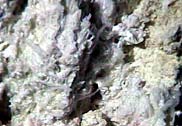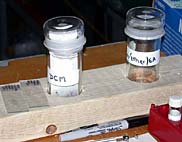|
|
|||||||||||||||||||||||||||||||||||||||||||||||||||||||||||||||||||||||||||||||||||||||||||||||||||
 |
|||||||||||||||||||||||||||||||||||||||||||||||||||||||||||||||||||||||||||||||||||||||||||||||||||
While the Atlantis sits on the surface all day, I often wonder how many people have sailed, steamed, or cruised over this very spot, perhaps even stared into the deep without notion of the remarkable ecosystem that lies beneath the water. Columbus? Conquistadors? Pirates? Marines, sailing for the shores of Tripoli? GIs headed to Africa and Normandy? One thing’s sure, we’re not the first ones here: yesterday Alvin spotted a drink bottle on the seafloor beneath Lost City! We are lucky enough to be among the first people here to explore the deep. But such questions get one thinking about the past...
What would the ocean floor of the Earth have looked like four billion years ago? Many geologists think the ancient ocean floor might have looked a lot like what we’re seeing at Lost City (with one caveat: the four-billion-year-old bottle hypothesis remains controversial). Today ocean crust is made mostly of a rock type called basalt. But four billion years ago, it may have been mostly peridotite – just like at Lost City. And since peridotite reacts with seawater to create the hydrothermal system at Lost City, similar systems might have been common on the ancient ocean floor. Therefore, Lost City might be a window into the past. This is exciting news! Microbiologists like Billy and Mausmi will tell you that the most ancient forms of life that we know of are the ‘weird’ bacteria and archaea that live at hydrothermal systems. They are trying to determine what bacteria and archaea live at Lost City. I’m interested in related questions: are the microbes living at Lost City similar to those that lived in hydrothermal systems four billion years ago? If so what can we learn about the ancient systems from Lost City? And what information about microbes past and present can we learn from the techniques of organic geochemistry? To answer these questions, I’m working with John Hayes and Roger Summons to study organic material preserved in the carbonates at Lost City. In particular we’re interested in studying lipids, which are chemicals that organisms use to (among other things) make their cellular membranes. Lipids are excellent chemicals to study for two reasons. For one thing, they are often exceptionally well preserved: many old rocks will still contain lipids long after the carbohydrates, DNA, and other organic material has been destroyed. The second reason is that the structures and isotopic compositions of lipids contain a lot of information about the organisms that produced them.
If an ancient analogue to Lost City were found in the geological record, information about microbes would likely be preserved only as lipids. But here at Lost City, we can study the microbes, the environment, and the lipids simultaneously. On board, John and I use a technique called Thin Layer Chromatography (TLC) to determine how much lipid material is present in each carbonate rock retrieved by Alvin. The photo shows this technique in action: a small amount of organic material is first removed from the rock, then spotted on a TLC plate placed in a jar with some solvent. The solvent moves upwards, along the TLC plate, and carries the lipid material with it. The TLC plate is made of a special silica gel that binds to some compounds more strongly than others.
Due to this property, our organic material is separated into various fractions. The second photo shows a developed TLC plate from one of our carbonate samples. There are about 10 dark spots, each representing a different type of lipid. This tells us that in this particular sample, the lipids contain a wealth of information! When we get back to land we can analyze these lipids with more sophisticated techniques and learn what they have to tell us. For now we continue to examine samples and think about this amazing system. If only the pirates knew what they were missing out on! |
|||||||||||||||||||||||||||||||||||||||||||||||||||||||||||||||||||||||||||||||||||||||||||||||||||



